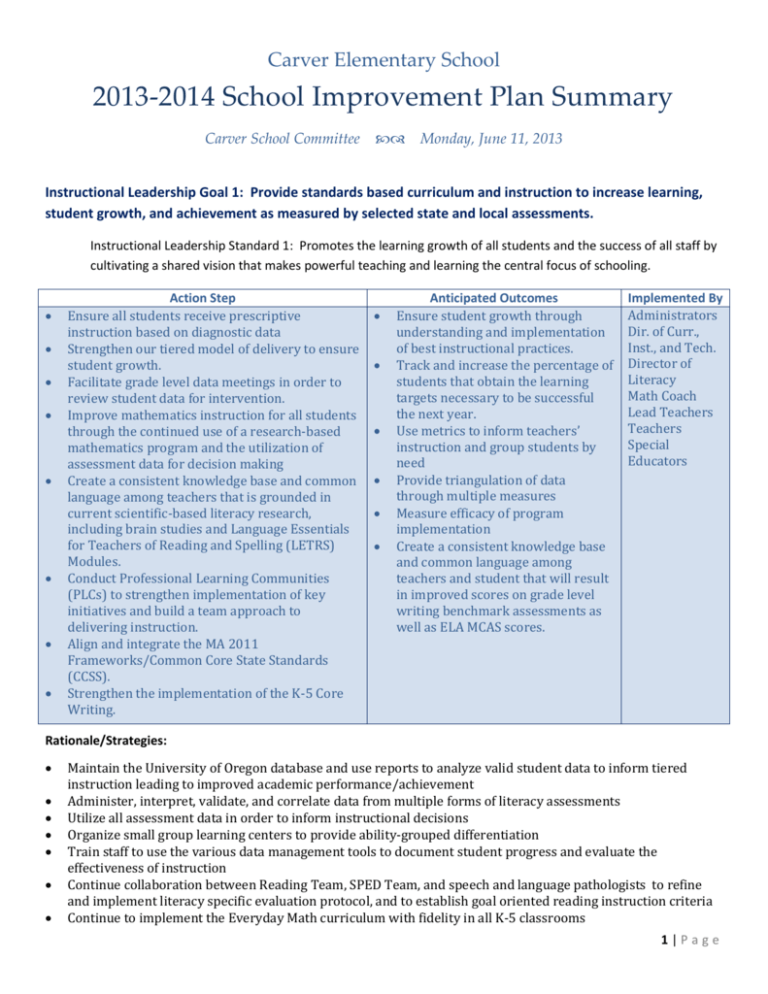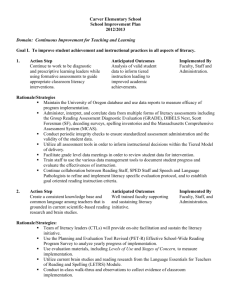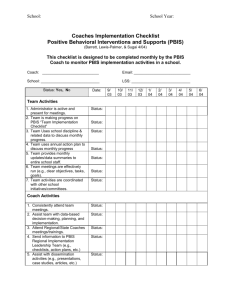for Elementary School 2013-2014
advertisement

Carver Elementary School 2013-2014 School Improvement Plan Summary Carver School Committee Monday, June 11, 2013 Instructional Leadership Goal 1: Provide standards based curriculum and instruction to increase learning, student growth, and achievement as measured by selected state and local assessments. Instructional Leadership Standard 1: Promotes the learning growth of all students and the success of all staff by cultivating a shared vision that makes powerful teaching and learning the central focus of schooling. Action Step Ensure all students receive prescriptive instruction based on diagnostic data Strengthen our tiered model of delivery to ensure student growth. Facilitate grade level data meetings in order to review student data for intervention. Improve mathematics instruction for all students through the continued use of a research-based mathematics program and the utilization of assessment data for decision making Create a consistent knowledge base and common language among teachers that is grounded in current scientific-based literacy research, including brain studies and Language Essentials for Teachers of Reading and Spelling (LETRS) Modules. Conduct Professional Learning Communities (PLCs) to strengthen implementation of key initiatives and build a team approach to delivering instruction. Align and integrate the MA 2011 Frameworks/Common Core State Standards (CCSS). Strengthen the implementation of the K-5 Core Writing. Anticipated Outcomes Ensure student growth through understanding and implementation of best instructional practices. Track and increase the percentage of students that obtain the learning targets necessary to be successful the next year. Use metrics to inform teachers’ instruction and group students by need Provide triangulation of data through multiple measures Measure efficacy of program implementation Create a consistent knowledge base and common language among teachers and student that will result in improved scores on grade level writing benchmark assessments as well as ELA MCAS scores. Implemented By Administrators Dir. of Curr., Inst., and Tech. Director of Literacy Math Coach Lead Teachers Teachers Special Educators Rationale/Strategies: Maintain the University of Oregon database and use reports to analyze valid student data to inform tiered instruction leading to improved academic performance/achievement Administer, interpret, validate, and correlate data from multiple forms of literacy assessments Utilize all assessment data in order to inform instructional decisions Organize small group learning centers to provide ability-grouped differentiation Train staff to use the various data management tools to document student progress and evaluate the effectiveness of instruction Continue collaboration between Reading Team, SPED Team, and speech and language pathologists to refine and implement literacy specific evaluation protocol, and to establish goal oriented reading instruction criteria Continue to implement the Everyday Math curriculum with fidelity in all K-5 classrooms 1|Page Refine the use of MCAS, Everyday Math, and easyCBM assessment data to document student progress and evaluate the effectiveness of instruction Continue to develop a concrete plan for providing mathematics intervention to the students most in need (Tier 2 and 3) by correlating data from assessments (Everyday Math, MCAS, and easyCBM) Align and integrate the CCSS by continued development of crosswalk document between Everyday Math and CCSS, power standards, and continued development on common assessments to achieve mastery of power standards Collect evidence of classroom implementation and analyze annual progress Provide in-class coaching and support to link information from the current research and best practices to classroom instruction Plan professional development for effective use of differentiated instruction and co-teaching models to support students and leaders Utilize time during staff meetings for grade level and intervention teams to share implementation highlights and instructional tools Provide in-class coaching and modeling to support program implementation Conduct ongoing training and focus groups on how to effectively implement interventions Collect student data to determine the efficacy of tier 2 & 3 interventions using the University of Oregon’s DIBELS Data System Conduct vertical team meetings to ensure implementation of an articulated curriculum Conduct professional development workshops at each grade level to evaluate MCAS data and compare these results to classroom performance in order to fine tune our implementation Continue to implement the Empowering Writers Program and continue to use Keys to Literacy strategies to support writing instruction Revise benchmark assessments to align with CCSS Continue to implement and refine benchmark writing assessments for each grade level Conduct guided grade level scoring sessions to review student work to ensure a consistent approach to teaching and evaluating writing Management and Operations Goal 2: Maintain current staff and programs while addressing the needs of the school buildings and implementing legal mandates utilizing available resources as measured by current staffing levels and programs, ongoing monitoring of building conditions, and compliance with legal mandates. Management and Operations Standard 2: Promotes the learning and growth of all students and the success of all staff by ensuring a safe, efficient, and effective learning environment, using resources to implement appropriate curriculum, staffing and scheduling. Action Step Establish common, clear and concise, and realistic behavioral expectations that will be determined and implemented by the whole staff. Increase data-based decision making on behavior and academic instruction and reinforced across all school settings. Explicitly teach behavioral expectations to all students building wide. Review and support students’ successful demonstration of expected positive behaviors through re-teaching and prompting. Anticipated Outcomes Increased student engagement in learning time. Stronger sense of community amongst staff, students and family. Improved secondary interventions for students receiving more than one or multiple discipline referrals to continue to prevent the need for more intense tertiary support. Decreased need for tertiary supports. Implemented By PBIS Team, Faculty, Staff, and Administration 2|Page Action Step Using the PBIS Model staff will develop increased awareness and recognition of positive expected behaviors throughout the school day, including methods using group and individual behavior management strategies. Staff will work together to inform families and community regarding PBIS initiative. Anticipated Outcomes Improved self-esteem and student/school culture. Increased family involvement. Decreased number of bullying incidents. Strengthen home/school expectations for positive behaviors. Implemented By Rationale/Strategies: Professional Development for the entire staff on PBIS, RTI, and other character education components Implement behavior teaching matrix with common lesson plans for all grade levels Collaborative planning time. PBIS team analyzes data and reports out at faculty meeting monthly PBIS lesson plans All staff will document teachable moments and interactions with students throughout the school day. Posters. School wide assemblies Recognition of student achievement. Use of group/individual management systems The PBIS leadership team will meet monthly to evaluate data/outcome measures Parent teaching. Resource distribution. Parent involvement via multiple modes of communication Provide workshops to families Family and Community Goal 3: Inspire family, community, and schools to partner in support of academic excellence, personal, social, and emotional growth, and school pride as measured by student achievement data, community attendance at school events, and number of discipline incidences. Family and Community Engagement Standard 3: Promotes the learning and growth of all students and the success of all staff through effective partnerships with families, community organizations, and other stakeholders that support the mission of the school and district. Action Step Increase participation from the community in school related literacy, math, and PBIS activities. Anticipated Outcomes Increased school and family communication about academic and behavioral expectations for success. Increased literacy in the community, summer reading, reading at home. Improved family awareness of incoming kindergarten readiness, parents’ role in school, and literacy development. Increase young families’ awareness of the importance of developing preliteracy skills from birth. Implemented By Faculty, Staff, and Administration Rationale/Strategies: Establish parent/community programs to inform and inspire literacy. Host an annual “Preschool Pajama Party” Advertise Summer Reading Initiative: Summer Book BINGO Involve local businesses in rewarding students for achievements related to the school-wide reading initiative: Read Across America 3|Page Continue to host annual “Community Readers Day” Develop and implement the “Books for Babies” newborn literacy initiative Organize Family Math Night for grades K-5 Establish PTO Parent Programs, i.e: Everyday Math Information Night and Scott Foresman Literacy Night Publish a math update in the monthly newsletter Professional Culture Goal 4: Revise and implement policies and procedures in order to emphasize reflective practices, high standards, effective communication, and continuous learning which are measured by the implementation of appropriate policies and procedures; Teacher Evaluation Tools; Administrative Evaluation Tools; NAEYC accreditation; NEASC accreditation; School-wide Positive Behavior Intervention Supports(PBIS); and Conflict Resolution. Professional Culture Standard 4: Promotes success for all students by nurturing and sustaining a school culture of reflective practice, high expectations, and continuous learning for staff. Action Step Improve our full day kindergarten program using the standards established by the NAEYC (National Association for the Education of Young Children) Implement the Massachusetts Kindergarten Entry Assessment using Teaching Strategies GOLD Anticipated Outcomes Maintain high standards for full day kindergarten and improved quality for learning. Maintain high standards for full day kindergarten. Provide developmentally appropriate differentiated instructional opportunities for students. Implemented By Faculty, Staff, and Administrators Rationale/Strategies: Provide professional development on NAEYC standards Provide training for new and existing kindergarten faculty members during the grade level professional learning community meetings and on full or early release PD days Provide trainings for paraprofessionals every other Friday throughout the school year Provide professional development for kindergarten teachers and paraprofessionals in implementing the assessment tool and observing and analyzing students. Focus kindergarten PLC on implementation with fidelity Coordinate with preschool, as applicable 4|Page








